Abstract
The interaction between human activity and landscape pattern has been a hot research topic during the last few decades. However, scholars used to measure human activity by social, economic and humanistic indexes. These indexes cannot directly reflect human activity and are not suitable for fine-grained analysis due to the coarse spatial resolution. In view of the above problems, this paper proposes a method that obtains the intensity of human activity from GPS trajectory data, collects landscape information from remote sensing images and further analyzes the interaction between human activity and landscape pattern at a fine-grained scale. The Lijiang River Basin is selected as the study area. Experimental results show that human activity and landscape pattern interact synergistically in this area. Built-up land and water boost human activity, while woodland restrains human activity. The effect of human activity on landscape pattern differs by the land cover category. Overall, human activities make natural land, such as woodland and water, scattered and fragmented, but cause man-built land, such as built-up land and farmland, clustered and regular. Nevertheless, human activities inside and outside urban areas are the opposite. The research findings in this paper are helpful for designing and implementing sustainable management plans.
1. Introduction
Human activity has a direct and indirect impact on landscape pattern [1], and their mutual relationship shows different characteristics with the development of society [2]. With the rapid growth of population and the improvement of the engineering skills of man, the impact of people on the natural environment is continuously increasing [3,4]; whereas in pre-history time, humans’ ability to change the environment was limited. Particularly after the Industrial Revolution since the 1740s, the scale of human impact has been considerably larger than at any point previously [5], and the landscape pattern of the Earth’s surface has significantly changed since then. According to [6], one-third of the humid forest in Southeast Asia disappeared between the beginning of the twentieth century and World War II. The arable land area has decreased more than 80% in the Gorce Mountains area in the past 50 years [7]. In addition, about 1% of the global coastal wetland stock is destroyed each year, caused by direct human reclamation [8]. Human activity and related socioeconomic variables have become very important factors influencing the change of the landscape [9]. On the other hand, the landscape also exerts an effect on human activity [10]. The lack of knowledge about the relationship between human activity and landscape could hinder the implementation of sustainable management plans [11]; therefore, understanding the interaction between them becomes an urgent need [12,13,14].
The advent of various kinds of airborne and satellite-based Earth observation platforms makes it possible to collect a large area of ground information, including landscape information, quickly and frequently [15,16]. This technology triggers research on investigating the coupling relationship between landscape and human activity [17,18,19]. Two main ways of studying the impact of human activity on landscape are: (1) making an assumption that a certain type of landscape change is caused by human activity and then analyzing the impact of humans based on the change of this type of landscape. Siyuan et al. analyzed the effect of human activities on the landscape in the Yellow River Basin based on local soil erosion [20]. Geri et al. assumed that human activity is the primary driving force of landscape pattern change and studied the effects of human activity by analyzing the heterogeneity of the Mediterranean landscape [21]. (2) The other is measuring human activity using indicators, such as socio and economic indexes, then inferring human activity and the resulting impact on the landscape. In order to assess the intensity of human activity, Lü et al. used road density, the area ratio of human settlements, industrial land and farmland [22]. Guo et al. calculated the human disturbance degree based on the proportion of construction, tourists, town and country effects [23]. Gu et al. selected four variables (the ratio of native and non-native species, wetland uses, surrounding landscape and wetland landscape characteristics) to represent human activity [24], while Hoang et al. chose socio-economic factors, including engagement in tourism, ethnic group, poverty rate, population growth and effect of preservation policy [25]. Zeng et al. and Garbarino et al. used Euclidean distance-based factors, including distance from buildings, roads and tourism lodges, as assessment indexes of human activity [26,27]. A few scholars also investigated the impact of landscape pattern on human activity. Di Giulio et al. summarized related literature and concluded that the landscapes meeting people’s biological and cultural needs tend to be human’s preference, while land use types, such as roads with high traffic frequencies, have a barrier effect on humans [10].
The first approach can only show an overall trend, since human activity is not quantified. As for the second approach, there are two problems: Firstly, the social and economic factors cannot reflect human activity accurately and directly. For instance, the poverty ratio is related to human activity, but the specific relationship between them is unknown. Secondly, the human activity indexes derived from socio-economic factors are usually at the scale of the administrative unit, far coarser than the scale of the land cover classification result; which hinders a deeper analysis on the coupling relationship between human activity and landscape pattern. Therefore, finding an approach to directly monitor human activity at a fine spatial scale is necessary. As location and wireless communication technologies develop and gradually become ubiquitous, more and more sensors are being used in various walks of life and are producing a large amount of data. This type of data collection process is called participatory sensing by [28]. Participatory sensing data are of various forms, including GPS trajectory data [29,30], cell phone positioning data [31,32], RFID data, etc., and provide an effective way to collect and represent a long time series of real-time human activity.
The objective of this paper is to analyze the fine-grained interaction between human activity and landscape pattern based on remote sensing images and GPS trajectory data. We hypothesize that: (1) the impacts of landscape on human activities are influenced by a landscape composition characterized by the composition percentage of land classes; (2) the impact of human activities on the landscape varies from land class to land class and also changes with the intensity of activities. Our major contribution is to propose using GPS trajectories to quantify human activity, to generate the spatial distribution of human activity with the same resolution as the land cover result and to discover the otherwise invisible fine-grained interaction characteristics.
The next section introduces the study area and experimental datasets and also presents the workflow of the methodology and the detailed methods. Section 3 demonstrates and discusses the experimental results in the Lijiang River Basin, China. Section 4 concludes with the limitations of this paper and points out future directions.
2. Materials and Methods
2.1. Study Area
The Lijiang River Basin is located in Guilin, China’s Guangxi Zhuang Autonomous Region, covering the geographic extent 110°3′55′′–110°56′58′′E, 24°37′12′′–25°55′13′′N (Figure 1). The beautiful rivers and mountains in this basin constitute hundreds of miles of famous Lijiang River karst landscape. The unique landform, water and cultural landscape provide rich resources for the rise and development of the local tourism industry [33]. Over 30,000,000 tourists visited this region in 2014. The fast development of the tourism industry greatly promoted the local economy and society during the last two decades, but Lijiang River Basin has witnessed severe environmental issues, especially the significant change of land cover and landscape pattern [34,35].
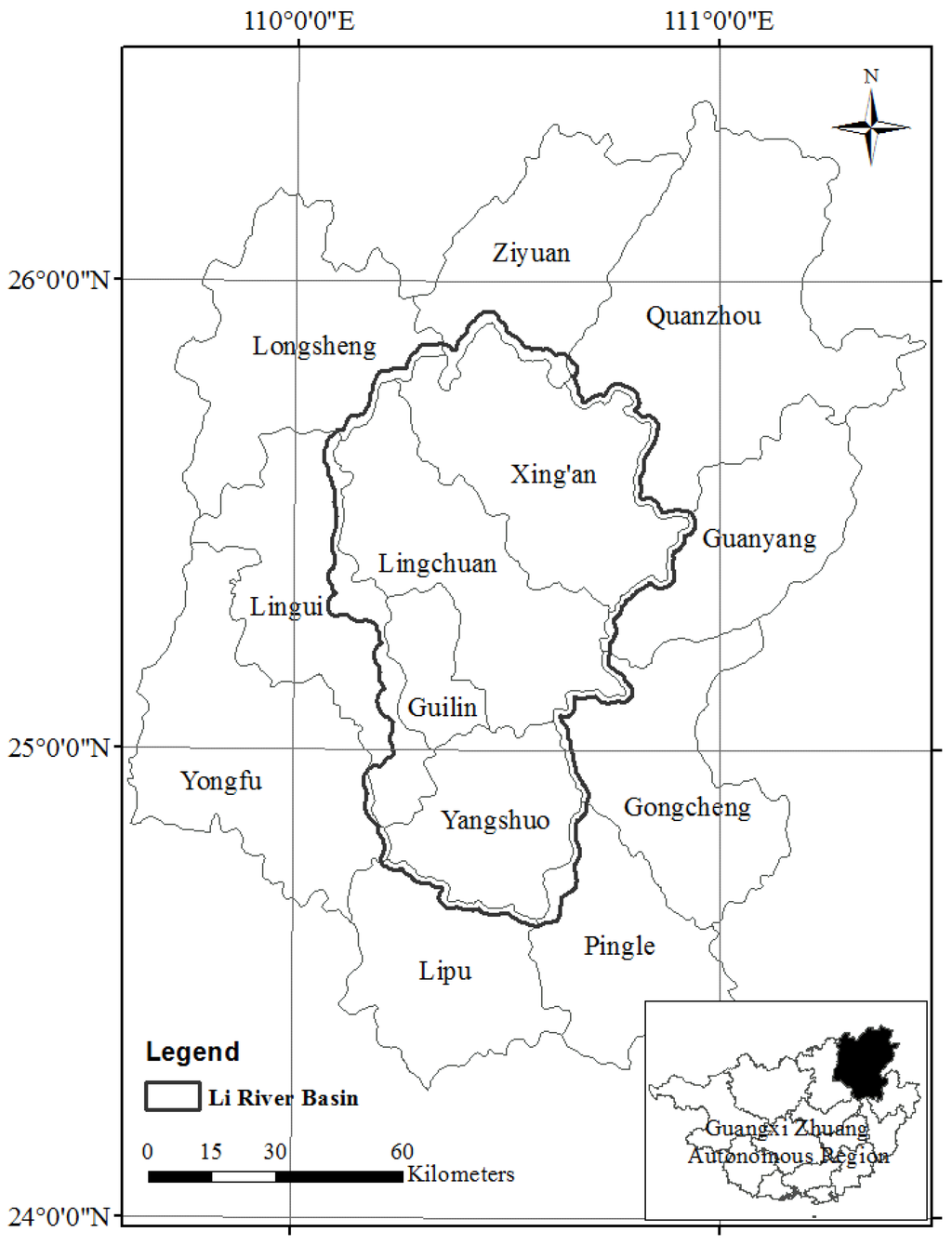
Figure 1.
Location of the study area.
2.2. Data Acquisition
Six datasets are used in this study: Landsat images, the ASTER DEM product, high spatial resolution remote sensing images from Google Earth, land use and cover products, GPS trajectory data and road vector data.
Landsat images of the study area in 2009 and 2013 were downloaded from the USGS data archive. The images in 2009 were collected by the Thematic Mapper (TM) on Landsat 5, while those in 2013 were collected by the Operational Land Imager (OLI) on Landsat 8. The spatial resolution of both TM and OLI images is 30 m. Four scenes of Landsat images (path: 124–125; row: 42–43) cover the study area, and the mosaic images are shown in Figure 2 in the form of a false color composite. The weather in the study area tends to be cloudy and foggy, which would not allow for a proper comparison. Thus, the Landsat images acquired between late October and early December when few clouds are visible are used, and the cloud-detecting algorithm proposed by [36] is applied to remove clouds before land cover classification.
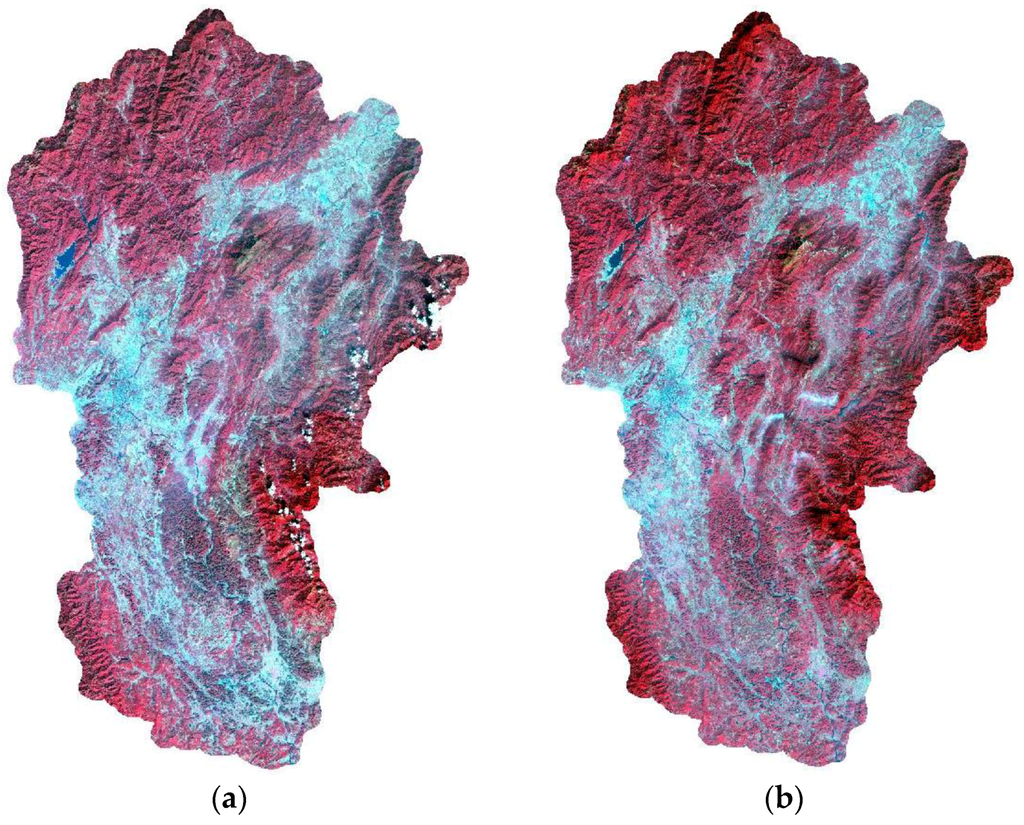
Figure 2.
False color composite image of Lijiang River Basin: (a) 2009; (b) 2013.
The ASTER GDEM is produced based on the observation data of NASA’s new generation of Earth observation satellites called Terra, which are available at the website of NASA’s Jet Propulsion Laboratory. The spatial resolution is 30 m. This dataset is used to compute the slope and aspect of the ground surface to facilitate land cover classification. The elevation-related information together with the spectral information can help improve the classification accuracy.
Google Earth is a virtual Earth product developed by Google Inc. and provides multi-temporal high resolution remote sensing images of many important regions in the world. The spatial resolution of images can be up to the meter level in some populated regions. These images are used as a land cover reference due to their timely and detailed information.
The land use/cover products include land use/cover maps and the topographic maps of nature reserves from the local tourism bureau and statistics bureau. Although these products are not collected at the same time as Landsat images, they can be used as supplementary reference data after digitization and geometric correction. Besides, our research group made several on-the-spot investigations of land cover in the study area using GPS receivers and digital cameras and generated land use/cover data of a part of the study area as ground truth data.
GPS trajectory data are a typical type of participatory sensing data. The trajectory data used in this paper are collected by the National Commercial Vehicle Monitoring Platform (NCVMP) operated by the Ministry of Transportation of China. In the NCVMP, tourist shuttles and coaches are equipped with GPS receivers and wireless communication equipment and send their real-time location and motion parameters to a monitoring center while moving. GPS trajectory data across the country are accumulated in this center. The sampling interval varies from 30 s–5 min, and the positioning accuracy is from 5–10 m. Figure 3a shows the spatial distribution of raw vehicle tracking data in the study area, which were collected in 2012. The tourist shuttles and coaches are two dominant transportation tools within Guilin, since the number of private cars per capita in China and Guangxi is extremely small [37,38], and, thus, can well reflect the activity of both local residents and outside visitors. The dataset is composed of the following information: vehicle ID, province ID, latitude, longitude, speed, direction, status and collection time. Part of the GPS tracking data is shown in Table 1.
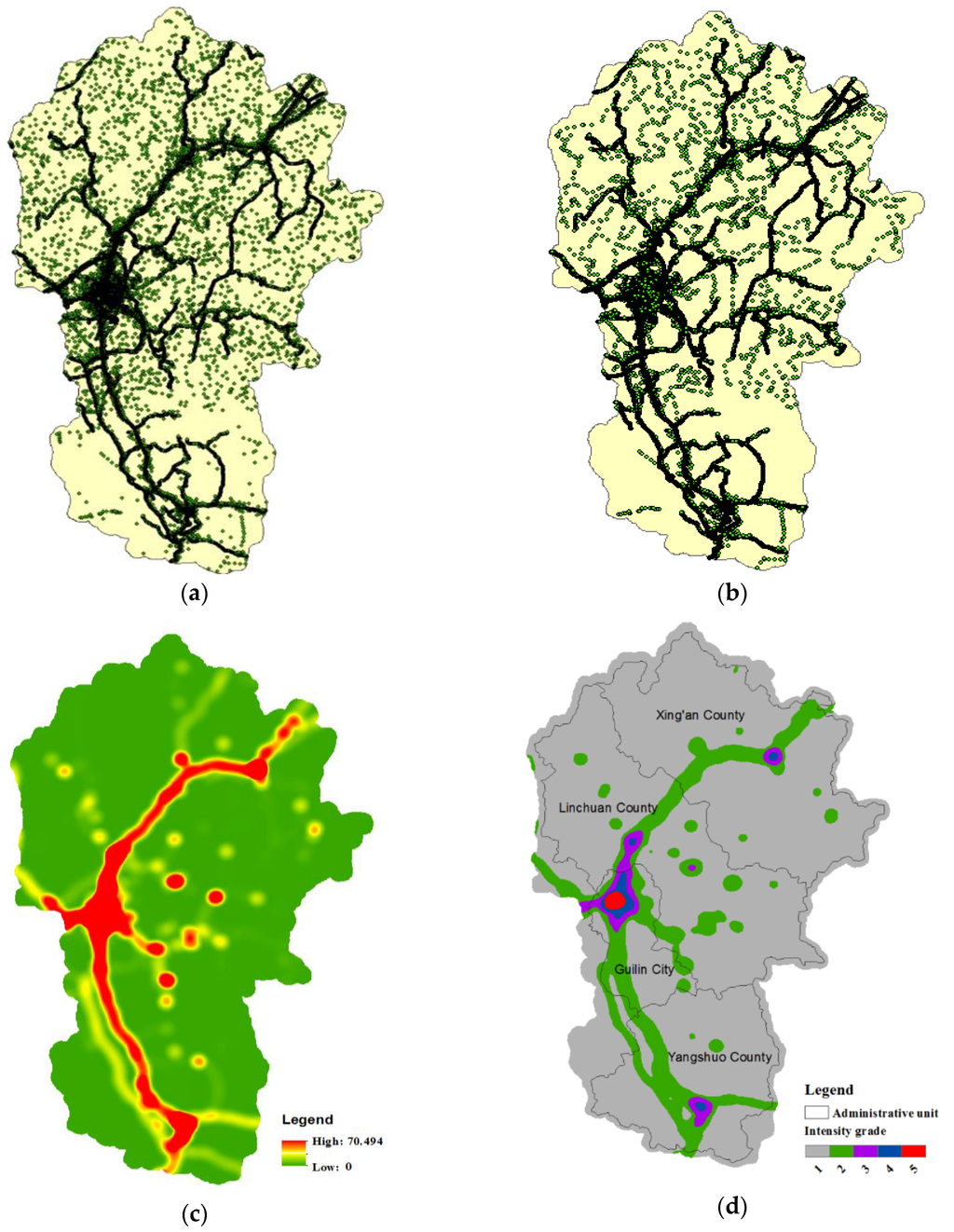
Figure 3.
Human activity analysis in Lijiang River Basin. (a) Raw GPS trajectories; (b) GPS trajectories after preprocessing; (c) intensity distribution; (d) intensity grade.

Table 1.
Part of the GPS tracking data in Lijiang River Basin.
Road vector data are from the 1:10,000 basic geographical database of Guilin City collected by the Guangxi Bureau of Surveying, Mapping and Geoinformation. The vector road network is used to filter out noisy GPS data.
2.3. Workflow
The overall workflow is composed of three steps, as shown in Figure 4: landscape pattern calculation, activity intensity calculation and interaction analysis. Four datasets (Landsat images, ASTER GDEM, Google Earth images, land use/cover products) are used in the first step, and they are split into two parts: one part for classification model training and another for validation. The land use/cover result is generated through the object-oriented image classification method and further used to derive landscape pattern status based on a group of selected landscape metrics. In the second step, we first conduct map matching between raw GPS trajectories and road networks to filter out noisy GPS points. We then use the kernel density estimation method to calculate the spatial distribution of activity intensity and further obtain its grading map by an established grading standard. Finally, based on the above three results, we conduct correlation analysis at both the landscape level and class level to explore the interaction characteristics between these two components.
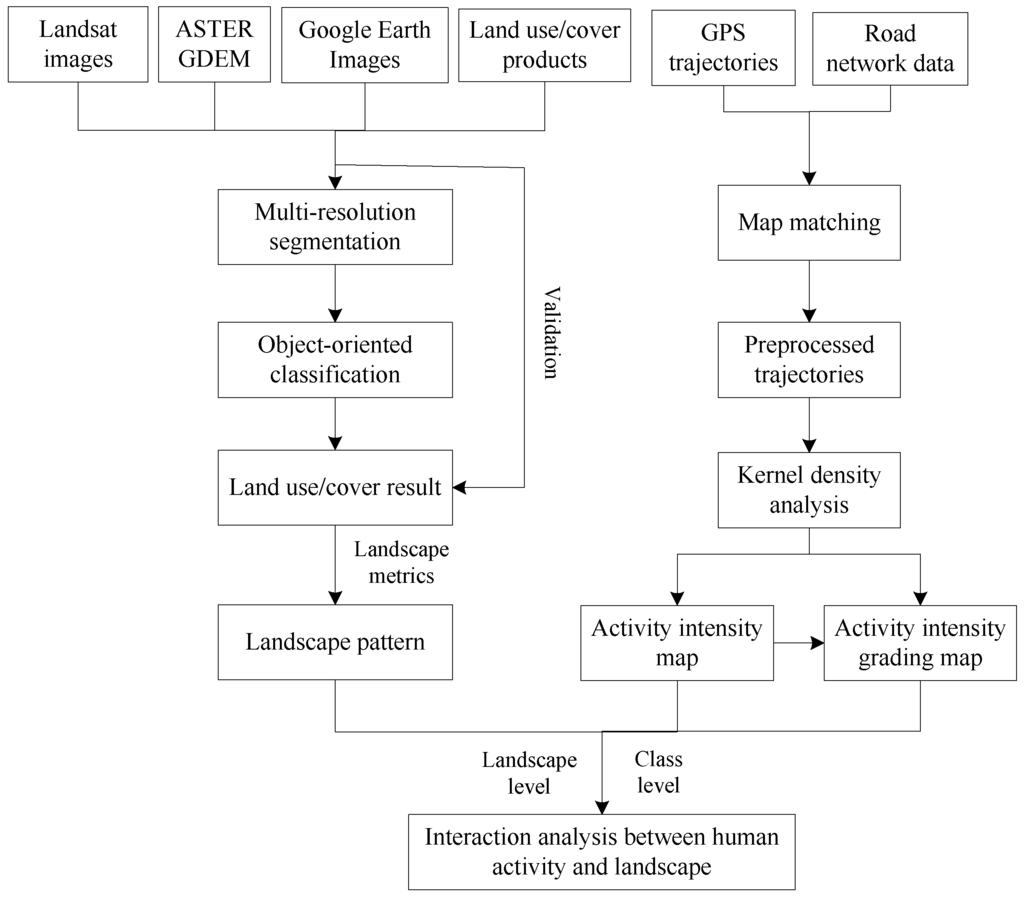
Figure 4.
Flowchart of the interaction analysis between human activity and landscape.
2.4. Landsat Image Classification
Remote sensing images of Lijiang River Basin are collected on two different paths of satellites, which makes the image acquisition conditions (sunlight strength, image acquisition angle, etc.) different. Using the same set of classification parameters to process images would lead to inconsistencies; therefore, the image classification is conducted scene by scene, and then, the classification results for each image are mosaicked. Land use/cover are divided into five types (woodland, water, built-up land, farmland and others) according to the local situation and our research needs. eCognition is used to implement the object-oriented classification [39] in which the multi-resolution segmentation [40] is selected with Landsat images, the derived NDVI products and DEM as input and the scale parameter set to 5. Before image classification, the high-resolution satellite images on Google Earth, the land use/cover products from government agencies and field surveying results are used as ground verification data for model training and validation. The overall classification accuracy is 84.25% by comparing classification results to the validation dataset. Figure 5 shows the land use/cover classification result.
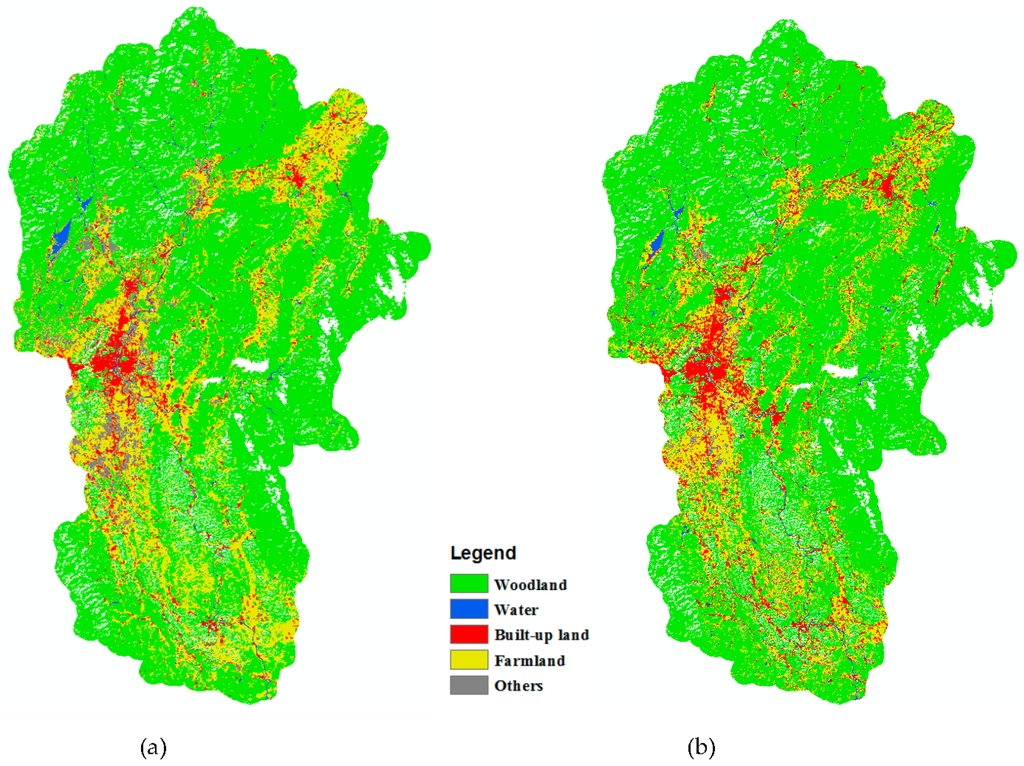
Figure 5.
Land use/cover in Lijiang River Basin: (a) 2009; (b) 2013.
2.5. Landscape Pattern Analysis
The landscape metric is a commonly-used landscape pattern analysis method based on categorical maps, especially the land cover/use classification result derived through remote sensing images. The basis or building blocks of categorical maps are patches whose internal heterogeneity is often ignored. Landscape metrics are a set of important mathematical indicators to quantify spatial characteristics and the distribution of patches. A large number of metrics have been proposed so far, such as the size, perimeter and shape of patches or patch density calculated by the number of patches per hectare. However, we choose only a few metrics, since some of them are correlated or have limited ability in describing specific landscape patterns [41,42]. We select five groups of metrics based on conceptual category: (1) area/density/edge metrics: patch density, edge density; (2) shape metrics: shape index; (3) core area metrics: total core area and core area density; (4) aggregation metrics: proximity index and contagion index; (5) diversity index: Shannon’s diversity index. Using the land cover/use classification result in Section 2.4, we apply the spatial analysis program Fragstats 4.1 [43] to compute the landscape metrics in Lijiang River Basin between 2009 and 2013, with an 8-cell neighborhood rule. The landscape pattern analysis is performed at two scales: the landscape level and the class level; however, the metrics used for these two scales are slightly different due to the applicability of the metrics. The output can either be a value for each metric or a continuous surface grid when the metric is calculated for each pixel.
2.6. Human Activity Analysis
Noisy points exist in raw GPS trajectory data due to various kinds of factors impacting positioning accuracy, such as the multiple-path effect and signal blocking. Before conducting activity analysis, we use the map matching algorithm [44] to filter out the noisy points that do not match with road networks.
Human activity intensity is the amount of human activity per unit area per unit time. GPS trajectory data can reflect fine-grained human activity well, and considering its characteristics, the metric based on GPS trajectory data is defined as the number of trajectory points per unit area per unit time. This metric is intrinsically the activity density of vehicles. Considering that the simple density calculation method is sensitive to the analysis scale and ignores the impact of subject on the surrounding area, we choose the kernel density calculation method [45,46]. The Gaussian kernel is used to represent the uniform decay of human influence as the following formula:
where h is the bandwidth, n is the number of points within the bandwidth, xi is the location of point objects and x is the location to calculate density. The bandwidth is set to 1000 m according to [47] in which Kong et al. studied the spatial distribution characteristics of human-impacted landscape and found the distance of significant impact on landscape to be between 1000 and 1200 m. The grid cell size for the calculation is set to 30 m to let the calculation result be consistent with the land cover result.
2.7. Interaction Analysis between Human Activity and Landscape Pattern
In order to better explore the interaction and coupling mechanism between these two components, we investigate the two effects separately based on the following observations: the difference in the spatial distribution of human activity intensity at one time is mainly determined by the landscape, and so, it can reflect the impact of the landscape pattern on human activity; yet, the evolution of the landscape pattern with time in a region is mainly caused by human activity and can reflect the effect of human activity on landscape. In order to understand the difference of density values in a semantic context, we classify intensity values into five grades. The approach to choose threshold values is as follows: first, intensity contour lines are generated based on the intensity image, and then, the contours that best fit to the boundaries of the geographical functional regions of Guilin are selected and their associated values used to establish the grading standard shown in Table 2. After grading, the difference of human activity intensity matches with the difference of functional characteristics. Correlation and evolution analysis is performed between human activity intensity (or intensity grade) and the landscape pattern index to explore the fine-grained interaction between the two components.

Table 2.
Grading standard of human activity intensity.
3. Results and Discussion
3.1. Landscape Pattern in the Lijiang River Basin
Table 3 shows the change of landscape indexes at the landscape level in Lijiang River Basin from 2009–2013, including patch density (PD), edge density (ED), Shannon’s diversity index (SHDI), contagion index (CONTAG), mean proximity index (PROX_MN), mean shape index (SHAPE_MN), total core area (TCA) and disjunct core area density (DCAD). The PD goes up to 2.3316 from 1.7139, and the ED also experiences a slight increase from 30.5714–34.3983. The CONTAG drops to 66.1679% from 66.3172%. The change of these indexes shows that the landscape becomes more and more fragmented during the four years. On the other hand, the SHDI keeps stable, which indicates that the diversity of landscape does not change too much, even though the landscape is experiencing fragmentation.

Table 3.
Metrics at the landscape level in Lijiang River Basin between 2009 and 2013 (PD = patch density, ED = edge density, SHDI = Shannon’s diversity index, CONTAG = contagion index, PROX_MN = proximity index mean, SHAPE_MN = shape index mean, TCA = total core area, DCAD = disjunct core area density).
Table 4 demonstrates the change of landscape indexes at the class level. The patch densities of built-up land and farmland are larger than those of woodland and water in both 2009 and 2013, indicating that the fragmentation degree of built-up land and farmland is more severe. Comparing the differences of landscape indexes between 2009 and 2013, it can be found that NP (number of patches) and PD are increasing for every land class.

Table 4.
Metrics at the class level in Lijiang River Basin between 2009 and 2013.
3.2. Human Activity Distribution
Figure 3b shows GPS trajectory data after preprocessing. The intensity image of human activity is calculated using the formula in Section 2.6, and the result is shown in Figure 3c. The highest intensity value is 70,494. Different colors are used to display the strength of human activity. Red regions represent strong human activity; yellow represents medium strength; while green shows weak human activity. Figure 3d shows the spatial distribution of human activity for different intensity grades. It can be seen that the human activity of Grade 1 mainly appears in the remote natural areas; the Grade 2 region spreads along major roads; the Grade 3 region is the suburban area; and the Grade 4 and Grade 5 regions are a belt region around downtown and the downtown area, respectively. The covering area percentages of human activity from Grades 1–5 are 83.6%, 13.9%, 1.6%, 0.6% and 0.3% respectively. It can be concluded that the highly intensive human activities are distributed in a relatively small portion of the basin.
3.3. Interaction Analysis Result between Human Activity and Landscape Pattern
Figure 6a,b illustrates the percentage of land (PLAND) for different intensity grades of human activity for each landscape element in 2009 and 2013, respectively. Overall, the change trend of PLAND with intensity grade in 2009 is very similar to that in 2013 for every land class. In addition, the composition percentage of the five land classes for different intensity grades is also similar in the two time periods. The above phenomena manifest that the relationship between landscape and human activity in Lijiang River Basin is time independent.
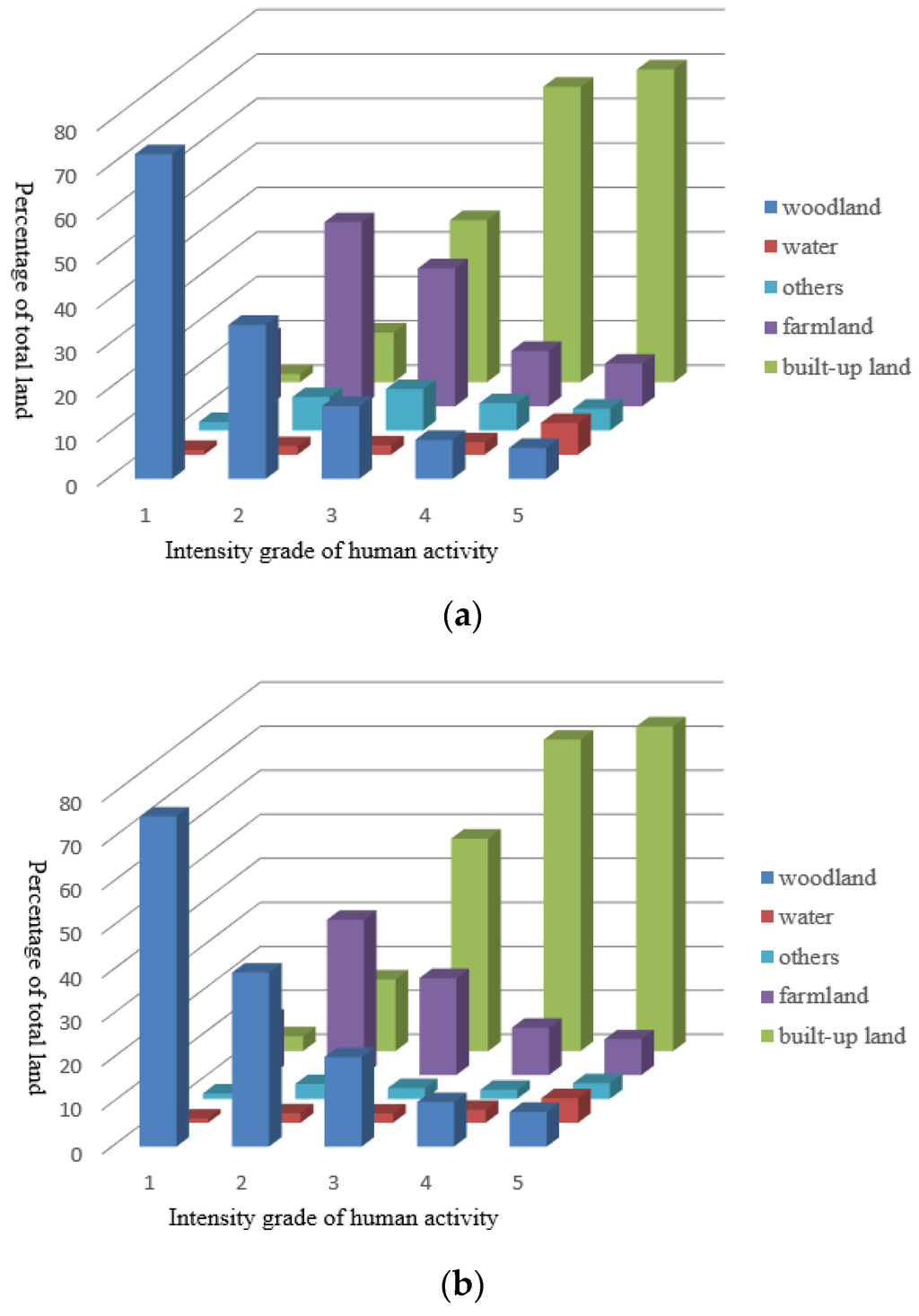
Figure 6.
Land percentage for different intensity grades of human activity: (a) 2009; (b) 2013.
Figure 6 also illustrates the dominant land class in regions with different grades of human activity. The most important land class in the Grade 1 region is woodland accounting for nearly 80% of total area, which indicates that very few people live in woodlands. There are very little built-up land and water in this region, the percentage of which is less than 2%. In the Grade 2 region, the percentage of woodland significantly drops down to about 36% compared to that in the nature dominant area. The farmland and built-up land account for about 40% and 12%, respectively. The PLAND for each land class is relatively balanced, which is likely because there are many roads and scenic spots in this region. In the Grade 4 and Grade 5 regions characterized by intensive human activities, the PLAND of built-up land increases to around 70%, and the areas of woodland, water and farmland are close. These two regions together are the urban area of Guilin, indicating that the dominant land class is built-up land. Overall, the dominant land class gradually changes from woodland to built-up land from the Grade 1 region with the weakest human activity to the Grade 5 region with the most intensive activity.
By analyzing the change of human activity intensity with PLAND, we find that the effects of woodland, water, built-up land and farmland on human activity show an obvious monotonic pattern. The intensity of human activity significantly increases as the PLAND of built-up land and water grows, and it also increases as the PLAND of water goes up, but the growth rates are slower. In other words, the people in Lijiang River Basin prefer to live in the regions with more built-up land and water, but the need for built-up land is larger than water. A contrary trend is found for woodland compared to built-up land and water: as the woodland percentage decreases, the intensity of human activity significantly increases. This indicates that woodland restrains human activity. The above results reinforce two previous research findings in a more precise way: water is a key factor evoking interest, calm and positive feelings and, therefore, has a high aesthetic preference [48]. In contrast, dense forests are less preferred [49]. It can be inferred that the most attractive landscape element composition is a high portion of built-up land and a certain amount of woodland and water.
We analyzed the impact of human activity on landscape based on the change of the landscape element in the same region. Figure 7a shows the change of PLAND of woodland during the four years from 2009–2013. It can be seen that in the region with the intensity value between zero and 7000, which is the nature dominant areas and the outskirts of Guilin, the PLAND of woodland increases as time goes by, and the amount of the increment grows as the activity intensity increases. This indicates that this region has witnessed afforestation during this time period. In addition, the PLAND of woodland increases in the region with an intensity value between 20,000 and 50,000, but decreases in the region with an intensity value over 50,000. It can be concluded that the greening rate increases in most urban areas, but drops down in crowed areas where human activity is most intensive.
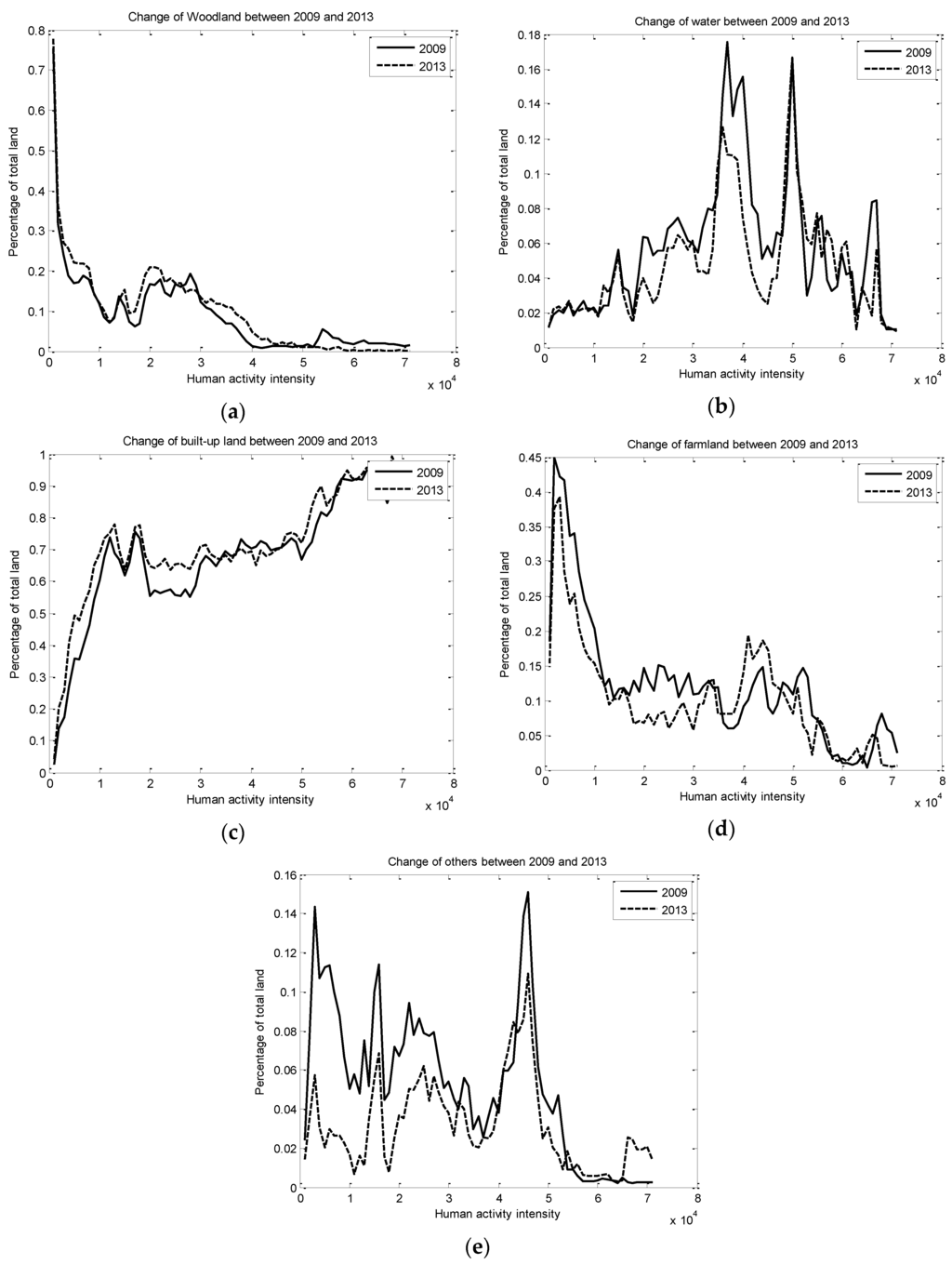
Figure 7.
Change of land percentage with human activity intensity between 2009 and 2013. (a) Woodland; (b) water; (c) built-up land; (d) farmland; (e) others.
Figure 7b shows the change of water during the same time period. We can find that the total area of water decreases in four years, and the regions where water area is decreasing are mainly those with strong human activity (the intensity value is over 20,000). In the regions with less intensive human activity, the area of water keeps stable, indicating that the shrinking of water happens mainly within the urban area and is probably caused by human activity.
Figure 7c demonstrates the change of built-up land during four years. Overall, the built-up land shows a growth trend. In the regions with weak human activity, the increment of built-up land is obvious, and the amount of increment rises as the activity intensity increases. The PLAND of built-up land does not change much in the regions with an intensity value over 30,000. The large gap between 20,000 and 30,000 reflects that the regions where the built-up land significantly increases are not the most developed areas of the city, but the fast developing outskirts of the city.
Figure 7d shows the change of farmland. Overall, the total area of farmland decreases from 2009–2013, and the regions where the decrement happens are mainly suburban areas. Looking at the increment of woodland in the same region, it can be inferred that the Grain for Green policy, a program undertaken by China’s government for converting the sloped cropland to forest or grassland in order to tackle deforestation, has an effect in Lijiang River Basin, which is among the first regions to stipulate this program [50].
Figure 7e shows the change of other types of land. Overall, the percentage of other land shows a decreasing trend, especially in the nature dominant area and the suburban area. The area keeps stable in other regions.
PD is also selected as a metric for further analyzing the relationship between human activity and landscape. Figure 8 shows the change of PD with human activity density. It can be seen that as the intensity of human activity increases from the nature dominant area (Grade 1 area) to the road dominant area and suburban area (Grade 2 and Grade 3 areas), to the city core belt (Grade 4 area), the PD increases as well; in other words, the landscape becomes more and more fragmented, and the degree of fragmentation grows while the activity intensity increases. However, in the city core area whose intensity grade is 5, although the human activity intensity increases, the PD drops down, which is contrary to the overall change trend. It can be inferred that the effect of human activity on landscape within the urban area is influenced by city planning rules or regulations, and the human activity is more regular than that in other areas. In addition, the comparison results of PD between 2009 and 2013 show that the human activity in the non-urban area is becoming more fragmented, while that in the urban area is becoming more regular as time goes by.
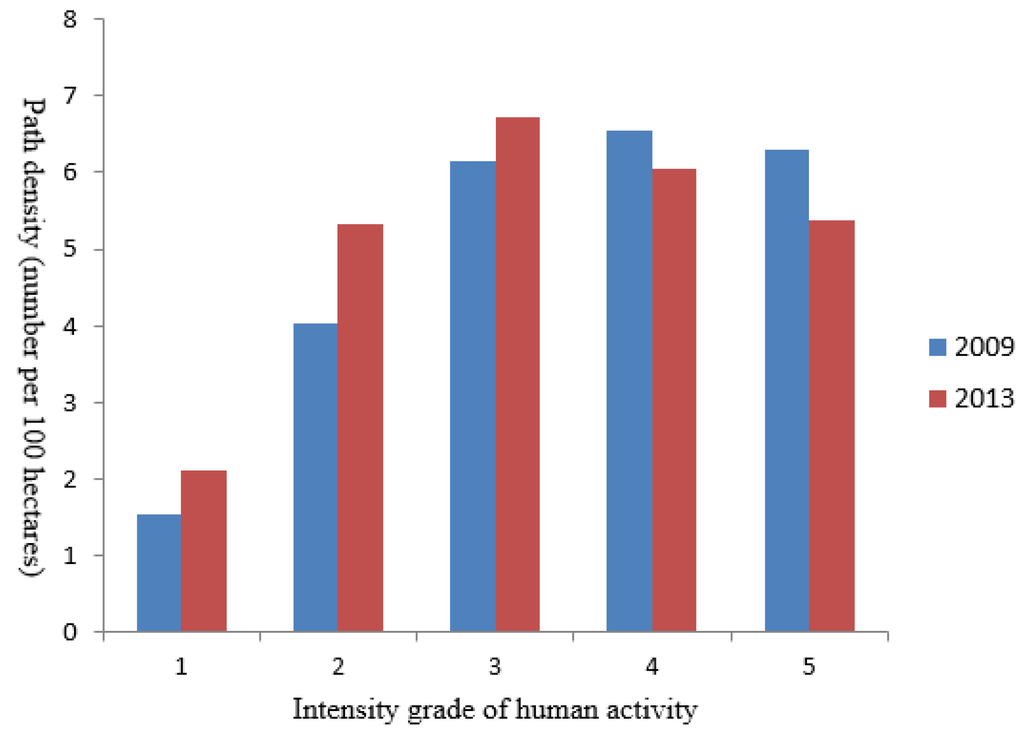
Figure 8.
Change of patch density with human activity intensity at the landscape level.
Compared to the landscape-level result, the result at the class level provides an insight into the relationship between human activity and the degree of fragmentation of each land class, as shown in Figure 9. It can be seen that the PD of woodland, water and other land classes (mainly grassland and shrub in the study area) increases with activity intensity. On the contrary, the PD of built-up land and farmland decreases with the growth of activity intensity. The former three land classes are human activity-influenced natural land, while the latter two land classes are man-built land. Therefore, we can infer that overall, human activity causes the natural land to become fragmented while transforming it, but making the man-built land more regular. However, in urban areas, woodland and other land classes are becoming more clustered, which shows a contrary change trend with the overall trend. This further enriches the research results on landscape at a finer scale: human activity generally imposes opposite impacts on natural land and man-built land, but its impacts on natural and man-built land are the same (clustered and regular) within urban areas due to the city and landscape planning regulations.
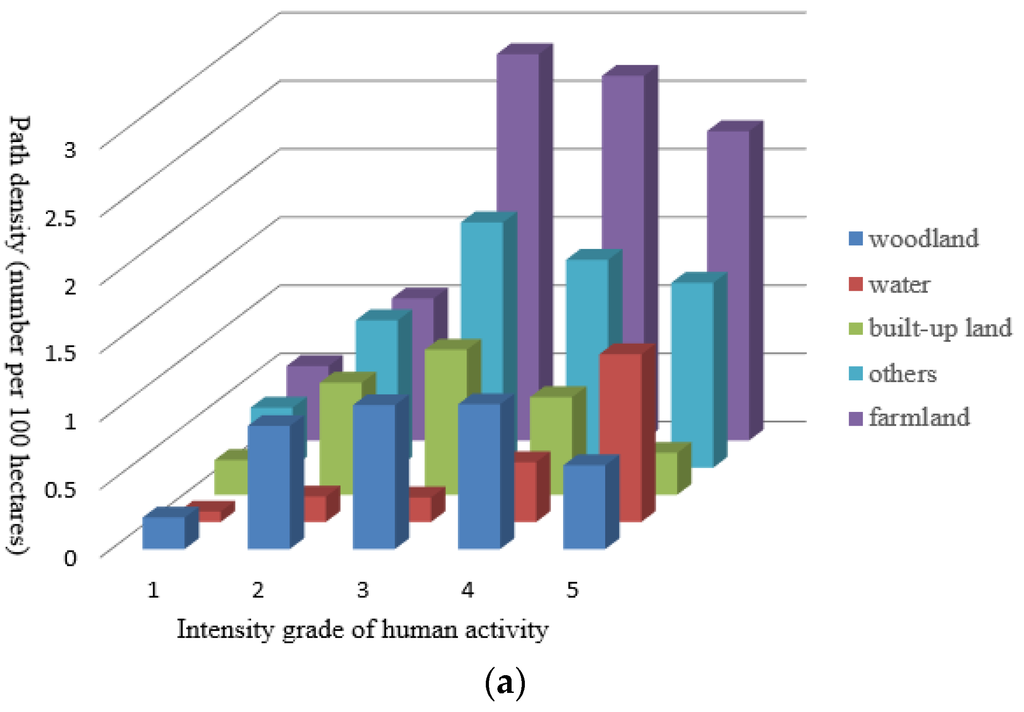
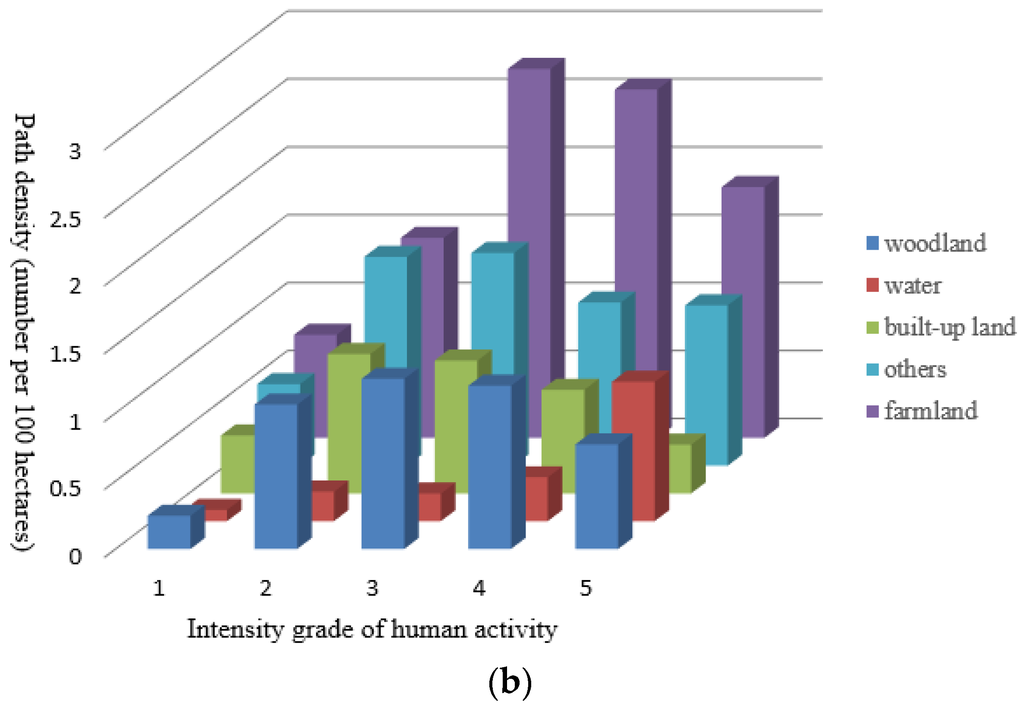
Figure 9.
Change of patch density with human activity intensity at the class level: (a) 2009; (b) 2013.
4. Conclusions
The advent of remote sensing technology characterized by airborne and satellite-based Earth observation platforms provides an effective way to continuously monitor the change process of landscape; meanwhile, participatory sensing data generated by humans have become a direct way of collecting human activity at high spatial and temporal resolution. Inspired by the cross and integration of geographic processes, ecological processes and emerging subjects envisioned by [51,52], this paper proposes the idea of the integrated use of remote sensing and participatory sensing data to analyze the interaction between human activity and landscape pattern at a fine-grained scale. The Lijiang River Basin in China’s Guilin City is selected as the study area. Experimental results show that human activity and landscape pattern are mutual impact factors in Lijiang River Basin. The research findings are two-fold: (1) as for the impact of landscape on human activity, by analyzing the change of human activity with the change of land percentage for each land class, we find that built-up land and water boost human activity, and humans are clustered in the regions with a large portion of built-up land and water; on the contrary, woodlands restrain human activity; (2) as for the impact of human activity on landscape, its impact on landscape differs from land class to land class. Overall, human activities tend to cause natural land, such as woodland and water, to become scattered and fragmented, and the degree of fragmentation increases with the growth of activity intensity, while they make man-built land, such as built-up land and farmland, clustered and regular. Nevertheless, the human activity within the urban area is opposite from that outside the urban area: the human activity in the suburban area is relatively unconstrained, while that within cities is standardized and regular.
Although this work has made progress in applying emerging technologies to landscape research, we need to note the following aspects: (1) compared to the socioeconomic indexes in the existing literature, the trajectory intensity is a more direct and accurate indicator of human activity and makes the interaction analysis between human activity and landscape at the same spatial scale become possible. However, similar to other indexes, the trajectory intensity is not a comprehensive indicator yet, and it represents the mobility information. The analysis results in this paper reveal the interaction characteristics between the two components from the perspective of mobility. (2) Different from the bus schedules, the GPS trajectory data contain the whole journey information and can help derive the spatial distribution of human activity in continuous space. However, the rate of occupied seats is not taken into account due to data access difficulties. Though the trips taken by the bus are not equal to the number of bus rides, these two numbers can be deemed linearly related in the study area, because the tourist shuttles and coaches are two dominant transportation tools and are crowed most of the time. Therefore, the analysis result can still give an insight into the relationship between human activity and landscape. The use of more data, such as ticket statistics or mobile phone positioning data, if possible, would be helpful for a more detailed analysis.
More research work needs to be conducted for identifying a more comprehensive and deeper understanding of the human-landscape interaction, including the following:
- (1)
- Participatory sensing data are field-based, while remote sensing images are raster-based. These two datasets represent information in two completely different forms, which brings difficulties to the integrated analysis of data. How to build a model or devise a method to compare, overlay and fuse these two types of data would be a key problem to solve.
- (2)
- Every type of participatory sensing data is collected or created by a certain group of people and, thus, represents the activity of part of the entire population. In order to allow the analysis result based on participatory sensing data be more representative, more sources or forms of participatory sensing data need to be used. Therefore, the fusion analysis of multiple sources of data needs to be considered.
- (3)
- This study explores the interaction between human activity and landscape pattern from the point of view of intensity and ignores the type difference of the population. In fact, personal experience and the utility function also play a role in the effect of the landscape on humans. For example, favorite sites attract visitors because of the restorative effect caused by feelings, such as calm, happiness and being away from everyday life [53,54], but for local people, the visual characteristics of the landscapes are not as important as their functions [10]. Therefore, how the type of population influences the interaction between human and landscape would be focused on in the future.
Acknowledgments
This work was supported by the joint fund of the National Natural Science and Civil Aviation research foundation of China (No. U1533114), National Natural Science Foundation of China (No. 51404272) and National Science and Technology Pillar Program of China (No. 2012BAC16B04). The authors would like to thank the three anonymous reviewers whose comments and suggestions greatly improved the manuscript.
Author Contributions
Jun Li designed and implemented the data analysis methods and wrote the manuscript. Yuan Zhang and Xiang Wang assisted with the data analysis and manuscript preparation. Qiming Qin supervised the data analysis, edited the manuscript. Zhuangzhuang Wei and Jingze Li assisted with the data analysis and participated in field work.
Conflicts of Interest
The authors declare no conflict of interest.
References
- Werner, B.T.; McNamara, D.E. Dynamics of coupled human-landscape systems. Geomorphology 2007, 91, 393–407. [Google Scholar] [CrossRef]
- Pan, Y. Human activities and geographical conditions. Yunnan Geogr. Environ. Res. 1990, 2, 19–28. [Google Scholar]
- Brad, M.A.; Gopalakrishnan, S.; McNamara, D.E.; Smith, M.D. Progress in coupling models of human and coastal landscape change. Comput. Geosci. 2013, 53, 30–38. [Google Scholar] [CrossRef]
- Liu, Y.; Luo, T.; Liu, Z.; Kong, X.; Li, J.; Tan, R. A comparative analysis of urban and rural construction land use change and driving forces: Implications for urban-rural coordination development in Wuhan, Central China. Habitat Int. 2015, 47, 113–125. [Google Scholar] [CrossRef]
- Vitousek, P.M.; Mooney, H.A.; Lubchenco, J.; Melillo, J.M. Human domination of earth’s ecosystems. Science 1997, 277, 494–499. [Google Scholar] [CrossRef]
- Lambin, E.F.; Geist, H.J. Regional differences in tropical deforestration. Environment 2003, 45, 22–36. [Google Scholar] [CrossRef]
- Bucała, A. The impact of human activities on land use and land cover changes and environmental processes in the Gorce Mountains (Western Polish Carpathians) in the past 50 years. J. Environ. Manag. 2014, 138, 4–14. [Google Scholar] [CrossRef] [PubMed]
- Hoozemans, F.M.; Marchand, M.; Pennekamp, H.A. A Global Vulnerability Analysis: Vulnerability Assessment for Population, Coastal Wetlands and Rice Production on a Global Scale, 2nd ed.; Delft Hydraul: Delft, The Netherlands, 1993. [Google Scholar]
- Fu, B.; Lu, Y.; Chen, L.; Su, C.; Yao, X.; Liu, Y. The latest progress of landscape ecology in the world. China Acta Ecol. Sin. 2008, 28, 798–804. [Google Scholar]
- Di Giulio, M.; Holderegger, R.; Tobias, S. Effects of habitat and landscape fragmentation on humans and biodiversity in densely populated landscapes. J. Environ. Manag. 2009, 90, 2959–2968. [Google Scholar] [CrossRef] [PubMed]
- Ministry of Forest and Soil Conservation. Sagarmatha National Park Management and Tourism Plan 2007–2012; Ministry of Forest and Soil Conservation: Kathmandu, Nepal, 2007. [Google Scholar]
- Nagendra, H.; Southworth, J.; Tucker, C. Accessibility as a determinant of landscape transformation in western Honduras: Linking pattern and process. Landsc. Ecol. 2003, 18, 141–158. [Google Scholar] [CrossRef]
- Ferrier, S.; Drielsma, M. Synthesis of pattern and process in biodiversity conservation assessment: A flexible whole-landscape modelling framework. Divers. Distrib. 2010, 16, 386–402. [Google Scholar] [CrossRef]
- Hudson, P.F.; LaFevor, M.C. Managing and monitoring human impacts on landscapes for environmental change and sustainability. J. Environ. Manag. 2014, 138, 1–3. [Google Scholar] [CrossRef] [PubMed]
- Yao, Y.; Liang, S.; Qin, Q.M.; Wang, K.; Zhao, S. Monitoring global land surface drought based on a hybrid evapotranspiration model. Int. J. Appl. Earth Obs. Geoinf. 2011, 13, 447–457. [Google Scholar] [CrossRef]
- Martinez, C.E.; García-Martin, A.; Longares, A.L.A.; Luis, M. Evaluation of forest cover change using remote sensing techniques and landscape metrics in Moncayo Natural Park (Spain). Appl. Geogr. 2015, 62, 247–255. [Google Scholar] [CrossRef]
- Liu, X.; Li, X.; Tan, Z.; Chen, Y. Zoning farmland protection under spatial constraints by integrating remote sensing, GIS and artificial immune systems. Int. J. Geogr. Inf. Sci. 2011, 25, 1829–1848. [Google Scholar] [CrossRef]
- Zhou, K.; Liu, Y.; Tan, R.; Song, Y. Urban dynamics, landscape ecological security, and policy implications: A case study from the Wuhan area of central China. Cities 2014, 41, 141–153. [Google Scholar] [CrossRef]
- Dufour, S.; Rinaldi, M.; Piégay, H.; Michalon, A. How do river dynamics and human influences affect the landscape pattern of fluvial corridors? Lessons from the Magra River, Central-Northern Italy. Landsc. Urban Plan. 2015, 134, 107–118. [Google Scholar] [CrossRef]
- Siyuan, W.; Jingshi, L.; Cunjian, Y. Temporal change in the landscape erosion pattern in the Yellow River Basin, China. Int. J. Geogr. Inf. Sci. 2007, 21, 1077–1092. [Google Scholar] [CrossRef]
- Geri, F.; Amici, V.; Rocchini, D. Human activity impact on the heterogeneity of a Mediterranean landscape. Appl. Geogr. 2010, 30, 370–379. [Google Scholar] [CrossRef]
- Lü, Y.; Chen, L.; Fu, B. The analysis of human activities and landscape pattern at the county level. Acta Ecol. Sin. 2004, 24, 1833–1838. [Google Scholar]
- Guo, L.; Xia, B.; Yu, S.; Gong, C. Effect of anthropogenic disturbances on the temporal-spatial changes of landscape patterns at Taishan Moutain. Chin. J. Eco-Agric. 2006, 14, 235–239. [Google Scholar]
- Gu, D.; Zhang, Y.; Fu, J. The landscape pattern characteristics of coastal wetlands in Jiaozhou Bay under the impact of human activities. Environ. Monit. Assess. 2007, 124, 361–370. [Google Scholar] [CrossRef] [PubMed]
- Hoang, H.T.T.; Vanacker, V.; Van Rompaey, A.; Vu, K.C.; Nguyen, A.T. Changing human-landscape interactions after development of tourism in the northern Vietnamese Highlands. Anthropocene 2014, 5, 42–51. [Google Scholar] [CrossRef]
- Zeng, H.; Kong, N.; Li, S.J. Human impacts on landscape structure in Wolong Natural Reserve. China Acta Ecol. Sin. 2001, 21, 1994–2001. [Google Scholar]
- Garbarino, M.; Lingua, E.; Marzano, R.; Urbinati, C.; Bhuju, D.; Carrer, M. Human interactions with forest landscape in the Khumbu valley, Nepal. Anthropocene 2014, 6, 39–47. [Google Scholar] [CrossRef]
- Goldman, J.; Shilton, K.; Jeff, B.; Estrin, D.; Hansen, M.; Ramanathan, N.; Reddy, S.; Samanta, V. Participatory Sensing: A Citizen-Powered Approach to Illuminating the Patterns that Shape our World; Woodrow Wilson International Center for Scholars: Washington, DC, USA, 2009. [Google Scholar]
- Zheng, Y.; Zhang, L.; Ma, Z.; Xie, X.; Ma, W. Recommending friends and locations based on individual location history. ACM Trans. Web 2011, 5. [Google Scholar] [CrossRef]
- Li, J.; Qin, Q.; Han, J.; Tang, L.A.; Lei, K.H. Mining trajectory data and geotagged data in social media for road map inference. Trans. GIS 2015, 19, 1–18. [Google Scholar] [CrossRef]
- Ratti, C.; Williams, S.; Frenchman, D.; Pulselli, R. Mobile landscapes: Using location data from cell phones for urban analysis. Environ. Plan. B Plan. Des. 2006, 33, 727–748. [Google Scholar] [CrossRef]
- Liu, Y.; Kang, C.; Gao, S.; Xiao, Y.; Tian, Y. Understanding intra-urban trip patterns from taxi trajectory data. J. Geogr. Syst. 2012, 14, 463–483. [Google Scholar] [CrossRef]
- Guilin Chorography Office. Guilin Chorography (1991–2005); Guilin Chorography Office: Guilin, China, 2011. [Google Scholar]
- Xiang, W.; Li, X.; Ding, T.; Huang, Y.; He, C.; Lu, S. Analysis on the vegetation landscape pattern of upper reaches in Lijiang River Basin. Guangxi Sci. 2009, 16, 455–459. [Google Scholar]
- Xiang, Y.; Meng, J. temporal and spatial analysis of tourism disturbance on landscape pattern in the Li River Basin of Guangxi. Mt. Res. 2014, 32, 11–20. [Google Scholar]
- Irish, R.R. Landsat-7 automatic cloud cover assessment algorithms for multispectral, hyperspectral, and ultraspectral imagery. Int. Soc. Opt. Eng. 2000, 4049, 348–355. [Google Scholar]
- National Bureau of Statistics of the People’s Republic of China, Statistical Bulletin of National Economy and Social Development of China in 2012. Available online: http://www.gov.cn/gzdt/2013-02/22/content_2338098.htm (accessed on 2 June 2016).
- Guangxi Zhuang Autonomous Region Bureau of Statistics, Statistical Bulletin of Economy and Social Development of Guangxi in 2012. Available online: http://www.gxtj.gov.cn/fzlm/zdgz/201304/t20130401_26110.html (accessed on 2 June 2016).
- Lucas, R.; Rowlands, A.; Brown, A.; Keyworth, S.; Bunting, P. Rule-based classification of multi-temporal satellite imagery for habitat and agricultural land cover mapping. ISPRS J. Photogramm. Remote Sens. 2007, 62, 165–185. [Google Scholar] [CrossRef]
- Rahman, M.D.; Saha, R.; Saha, S.K. Multi-resolution segmentation for object-based classification and accuracy assessment of land use/land cover classification using remotely sensed data. J. Indian Soc. Remote Sens. 2008, 36, 189–201. [Google Scholar] [CrossRef]
- Saura, S.; Martinez, M.J. Landscape patterns simulation with a modified random clusters method. Landsc. Ecol. 2000, 15, 661–678. [Google Scholar] [CrossRef]
- Neel, M.C.; McGarigal, K.; Cushman, S.A. Behavior of class-level landscape metrics across gradients of class aggregation and area. Landsc. Ecol. 2004, 19, 435–455. [Google Scholar] [CrossRef]
- McGarigal, K.; Marks, B.J. Spatial Pattern Analysis Program for Quantifying Landscape Structure; General Technical Report PNW-GTR-351; US Department of Agriculture, Forest Service, Pacific Northwest Research Station: Portland, OR, USA, 1995. [Google Scholar]
- Zhao, Y.; Qin, Q.M.; Li, J.; Xie, C.; Chen, R.Q. Highway map matching algorithm based on floating car data. In Proceedings of the 2012 IEEE International Geoscience and Remote Sensing Symposium, Munich, Germany, 22–27 July 2012.
- Rosenblatt, M. Remarks on some nonparametric estimates of a density function. Ann. Math. Stat. 1956, 27, 832–837. [Google Scholar] [CrossRef]
- Parzen, E. On estimation of a probability density function and mode. Ann. Math. Stat. 1962, 33, 1065–1076. [Google Scholar] [CrossRef]
- Kong, N.N.; Zeng, H.; Li, S.J. A study of the spatial distribution characteristics of human landscape impact in Wolong National Reserve, Sichuan Province. Acta Sci. Nat. Univ. Pekin. 2002, 38, 393–399. [Google Scholar]
- Ulrich, R. Aesthetic and affective response to natural environment. In Behavior and the Natural Environment; Altman, I., Wohlwill, J., Eds.; Springer: New York, NY, USA, 1983; pp. 85–125. [Google Scholar]
- Hunziker, M.; Kienast, F. Potential impacts of changing agricultural activities on scenic beauty—A prototypical technique for automated rapid assessment. Landsc. Ecol. 1999, 14, 161–176. [Google Scholar] [CrossRef]
- Mao, X.; Meng, J.; Wang, Q. Modeling the effects of tourism and land regulation on land-use change in tourist regions: A case study of the Lijiang River Basin in Guilin, China. Land Use Policy 2014, 41, 368–377. [Google Scholar] [CrossRef]
- Fu, B.; Zhao, W.; Chen, L. Progress and perspective of geographical-ecological progresses. Acta Geogr. Sin. 2006, 61, 1123–1131. [Google Scholar]
- Wu, J. Landscape Ecology: Pattern, Process, Scale and Hierachy; Higher Education Press: Beijing, China, 2007. [Google Scholar]
- Korpela, K.; Hartig, T. Restorative qualities of favorite places. J. Environ. Psychol. 1996, 16, 221–233. [Google Scholar] [CrossRef]
- Korpela, K.M.; Hartig, T.; Kaiser, F.G.; Fuhrer, U. Restorative experience and self-regulation in favorite places. Environ. Behav. 2001, 33, 572–589. [Google Scholar] [CrossRef]
© 2016 by the authors; licensee MDPI, Basel, Switzerland. This article is an open access article distributed under the terms and conditions of the Creative Commons Attribution (CC-BY) license (http://creativecommons.org/licenses/by/4.0/).